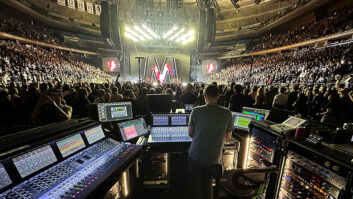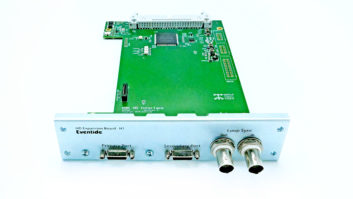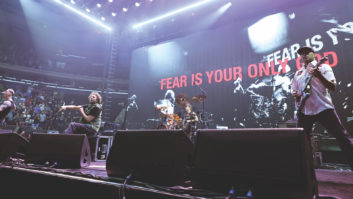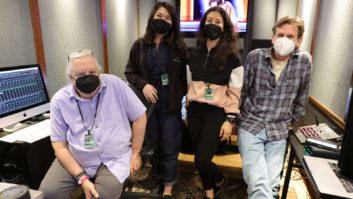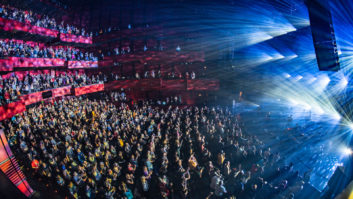The Eventide Eclipse is the company’s first single-rackspace effects processor, a must-have for those who need to fit Harmonizer® processing into a crowded outboard rack. The Eclipse is clearly based on Eventide’s H3000 and DSP-4000, which created and dominated the Harmonizer category for two decades, and includes many of the Orville’s algorithms. I had the opportunity to run the Eclipse while working on the Super Bowl half-time show (we used the Eclipse on Bono’s vocal), and I also packed it for a trip to Singapore and Seoul for another project — the 12-pound Eclipse is only a foot deep and runs on all international electrical standards.
CONNECTIONS ‘R’ US
The abundance of connectors on the back panel attest to the generous I/O and control options available. Besides both ¼-inch and XLR connectors for analog signals, there are also AES and S/PDIF digital connections, as well as an optical connector that can be set up for 2-channel S/PDIF or 8-channel ADAT. Wordclock I/O is provided on BNC connectors, and a 9-pin serial port provides PC connections.
The usual MIDI connectors include a 7-pin “In” port that can provide remote power to an appropriately equipped pedal board by plugging in its “wall wart” power supply at the back of the Eclipse. Two ¼-inch TRS jacks permit connection of foot pedals, voltage sources, or up to six footswitches to control parameters or trigger events. These features make the Eclipse a powerful platform for guitarists, and a review of its instrument-processing capabilities could easily fill another magazine. This is the Eventide product many musicians have been waiting for, but I’ll focus on features for sound engineers.
At the far left of the gray front panel are dual 7-segment LED meters. A convenient Levels menu button for adjusting global levels is located just below, and alongside it are five LEDs that indicate the sample rate (44.1 to 96 kHz) and whether the clock is provided from an external source. Yes, you can put this baby in a 96kHz digital signal chain, and its field-updatable operating system and factory presets make it future-proof.
The large, green, two-line display has four softkeys below it, along with an LED that reminds the user when the currently loaded program has been edited. Beside it are Program, Hot Keys and Parameter buttons to navigate the Eclipse. A massive, chrome soft-knob offers parameter adjustment, while the adjacent numeric keypad allows for manual data entry. The large, green, blinking TAP key provides constant notification of tempo and the interface for quickly entering a new one. Naturally, the tempo can be tied to delay times and LFOs, scaled with values from 1/16 to whole notes, but it can also control reverb times.
As with any powerful multiparameter effects unit, figuring out how to quickly edit a preset on-the-fly can be daunting. The Eclipse solution allows eight parameters to be quickly addressed via hot keys, accessed by the four soft buttons below the display in two pages. Hot keys may easily be assigned by holding down the key of a parameter, and can even be renamed.
COMPACT FLASH
Creating customized user programs, either from scratch or by modifying presets, requires a substantial investment of time. Other powerful machines have failed to make programming efforts portable by requiring expensive storage media or cumbersome computer hook-ups. On the Eclipse, the work of dozens of hours and thousands of keystrokes can be easily archived on Compact Flash cards, affordable offline storage media that can be carried in a pocket. A front panel slot accommodates matchbook-sized Compact Flash cards; they show up as memory locations 500 through 999.
The explosion in digital photography and handheld devices has had a welcome effect on CF card pricing; most digital cameras come with smaller capacity cards, and users quickly upgrade to larger 64, 128 and even 512MB cards. An 8MB card, now priced at under $10, easily stores 500 presets. We can only hope that this novel method for offline storage becomes a regular feature on other pro audio devices. It’s worth noting that devices with PCMCIA slots and Windows file structures can also make use of CF cards with a $10 adapter.
The Eclipse ships with about 250 factory presets, with 0 through 99 reserved for user memories. The 100 Series are single-machine presets that represent the range of individual Eclipse algorithms. Hey, it’s all here: delays, eight kinds of pitch shift, reverbs, dynamics and EQ. There are even utilities like an oscillator, an instrument tuner and an algorithm for dithering. Presets with familiar names from the H3000 or DSP-4000 families produce the same effects, and names ending with a “2” are similar, but have minor sonic differences. Locations 200 and above include both Legacy programs and many new, double-algorithm presets. Users can also create their own dual-algorithm presets by loading individual algorithms into either effects block.
With so many presets to choose from, it can be a challenge to find a particular sound quickly, but the Program menu divides the presets according to several criteria to help sort them. Presets can be arranged either alphabetically or numerically. Second, they can be searched based on a sound source category (guitar, vocals, drums, etc.), by effect type (pitch, reverb, delay, etc.) or both. Each time you save a preset, you also can flag these categories. Third, and most important for the working mix engineer, there are 10 user groups that can be customized with the project’s or artist’s name. Finally, searches can be limited to internal memory or to the Compact Flash card.
THE POWER OF TWO
The Eclipse is a two-engine machine, and an algorithm may be loaded into either of the two effects blocks. Routing options, which are a component of each preset, include the usual choices of series, parallel, dual (shared stereo outputs) and dual mono, as well as “xfade,” which allows smooth transitions from one effect to another and back.
Though higher sampling rates offer higher fidelity, some presets take advantage of the increased processing power available at lower rates for longer reverb and delay times. Some preset types are written for both 44/48 and 88/96kHz sampling, and a small indicator at the beginning of preset titles shows when the higher sample rates are available.
The Eclipse is a powerful tool, and, as you’d expect, it requires some practice to get up to speed on all of its features. However, by loading and tweaking factory presets, something useful can be found in moments. Micropitchshift (296) is the traditional H3000 standby (519) and live sound favorite, with nine cents of shift up and down available to give vocals presence and dimension. Mshift+Reverb8 (184) is a compound preset that combines pitch shift and reverb into a single algorithm block, but because it’s stored with 700 and 500 cents of shift and 10 seconds of reverb, it needs adjustment to be used in live sound applications. Alternatively, a separate reverb can be loaded into the second effect block of 296 to provide both doubling and reverb with a choice of routing options. Like other 2-channel, two-engine machines, dual inputs allow separate drives into two effects with shared stereo outputs.
There are a half-dozen different reverb algorithms to choose from (174 to 180), but, as with most effects used in live sound, the stock presets can benefit from some tweaking. Most of the reverb algorithms are better than on the old H3000, but Legacy presets, like Rich Plate (336), can also be found. Dense Room 16 (178) offers the most tweakability, with separate adjustments for early reflections and diffusion. All of the reverbs have simple high- and low-cut filters for EQ, but you can always patch a 4-band parametric into the second effect bank.
Who should buy one? With a list price of $2,999, the Eclipse is no more expensive than the H3000 when it first came out. While there are other more powerful digital mastering products, the Eclipse’s pristine sonic quality, plethora of connectors and high sample rate make it a versatile tool for tweaking, fixing and basic sweetening of digital or analog tracks.
The Eclipse is destined to become a classic, and anyone with an open rackspace who’s been waiting for their next Harmonizer should get in on the fun. And guitarists might as well cancel their cable TV for the next several months while they try it out.
Eventide, 1 Alsan Way, Little Ferry, NJ 07643; 201/641-1200; fax 201/641-1640; www.eventide.com.
Mark Frink is Mix‘s sound reinforcement editor.
